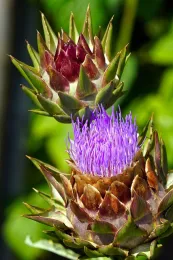Winter Dormancy: Gardening For the Fourth Season
The winter holidays are just around the corner, and hopefully you have your garden in order. Spring bulbs are planted. Garlic and potatoes are in the ground. Your garden has been “put to bed.” Tools have been sharpened and put away. Tender plants are mulched and waiting for the anticipated winter rains. Most plants are entering their dormant cycle and you, no doubt, are ready to join them.
Not so fast! Winter in the garden is a time for planting, pruning, and planning.
Take advantage of winter dormancy with bare-root plants

Now is the time to take advantage of winter dormancy. From December through March, your local nursery will have bare-root plants. These are plants that are dug while they are dormant, and they will have their roots exposed. Often, they are more affordable than containerized plants, and they are easier to handle.
You’ll find fruit trees, cane berries, asparagus, artichoke crowns, rhubarb, kiwi, strawberries, grapes, roses, and vines available as bare-root plants. Check with your local nursery early and after the first of the year. This gives you an opportunity to plan your location, prepare the planting hole when the ground is pliable but not soggy and get ready to welcome some new plants into your garden.
Understand the best time to prune
Mark your calendar: January is time for winter pruning, but you’ll want to plan and space your tasks between bouts of precipitation. Perennials that weren’t cut back in fall should be pruned in January. This is also the time to prune cane berries.
Fruit trees require pruning to shape the tree and open the tree center for the spring growth. If you already have fruit trees, January is the time to apply horticultural oil to control scale, mites, aphids, and other insects. Once again, check the weather and make certain that there are at least 24 hours of dry weather around the application.
Design with plant rotation in mind
Now before you relax and reach for the seed catalogues, grab a sheet of paper and make a quick drawing of last season’s vegetable and annual garden. Note where you planted each plant family and think about where you can rotate your plantings for the upcoming year. Plant rotation is an important step in sustainable gardening. Plant rotation builds and sustains helpful soil microbes, reduces the spread of soil-borne disease, helps plants take in more nutrients, and makes for a healthier garden.
The goal with plant rotation is to avoid planting the same plant families in the same location year upon year. Ideally, you will rotate plant families from one bed to another over at least a four-year period.
Planning is important before you shop those seed catalogues, because you don’t want to plan for too many tomatoes or melons if you haven’t set up a good rotation. Learning to identify which plants belong to the same family is your initial task. Tomato, pepper, eggplant, and potato belong together. Cucumber, melon, squash, pumpkins and gourds are related. Cabbage, broccoli, Brussels sprouts, kale, cauliflower, radishes are another family.
Once you have your families grouped and a rotation schedule established, you can finally kick off your shoes, surround yourself with your seed catalogues, and slip into the gardeners’ relaxed winter dormancy and dream of spring.
This article by Ola Jane Gow, UC Master Gardener of El Dorado County, first appeared in the Mountain Democrat.
Have a Gardening question? Use the “Ask a Master Gardener” button below or call 530-621-5512.
